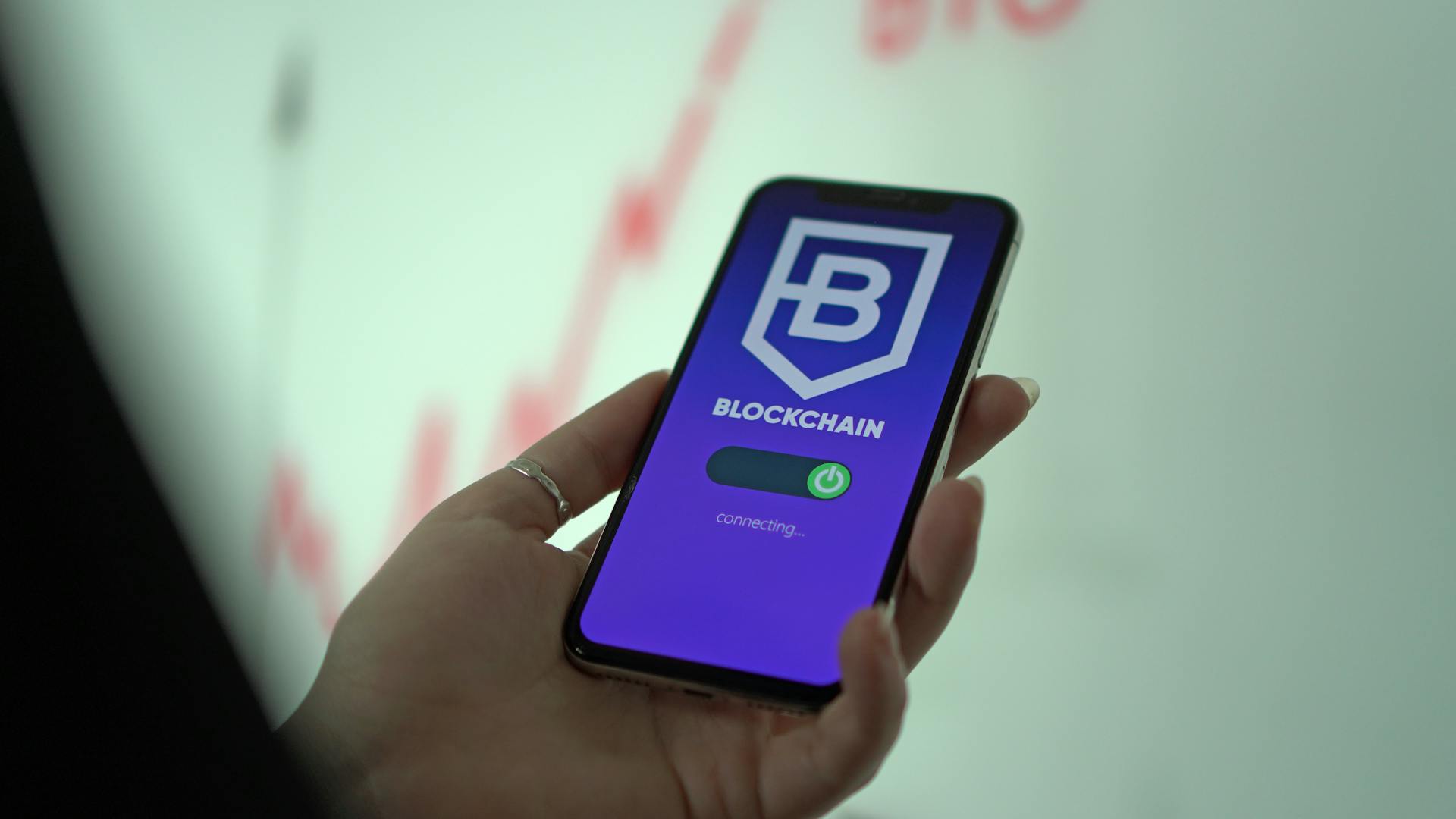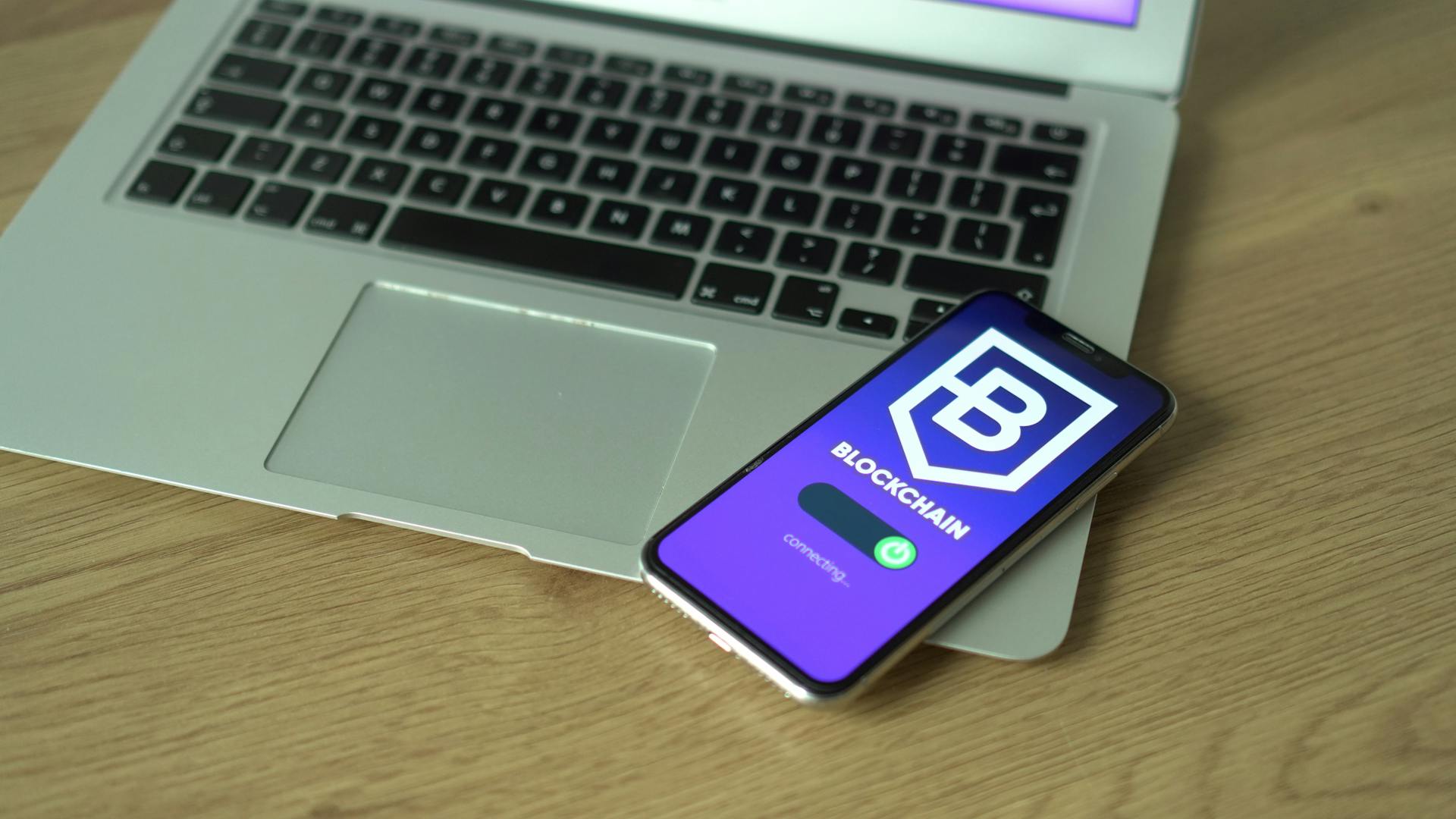
An Ethereum contract address is a unique identifier assigned to a smart contract on the Ethereum blockchain. It's a 42-character hexadecimal string that serves as the contract's public address.
The contract address is used to interact with the contract, send transactions, and retrieve data. It's also used to identify the contract's creator and owner.
Ethereum contract addresses are generated automatically when a contract is deployed to the blockchain. This is done through a process called deployment, where the contract code is compiled and sent to the network for execution.
Each contract address is unique, just like a person's fingerprint, and is used to verify the contract's authenticity and ownership.
Check this out: What Is Ethereum Used for
What is a Token?
Tokens don't exist in accounts, they exist in contracts that function like decentralized databases. These contracts map tokens to the appropriate Ethereum address.
The token contract governs and specifies the rules that apply to a given token. It's the contract that dictates the rules, not the account.
Developers set the name, symbol, and divisibility of a token when creating the contract. This information is crucial for identifying and working with the token.
With tokens living in contracts, it's the contract that holds the power, not the account. This is a fundamental aspect of how tokens work in Ethereum.
Creating and Viewing Tokens
Creating and Viewing Tokens is a breeze on the Ethereum blockchain. ERC-20 tokens are the most popular token specification on Ethereum, launched in 2015.
These tokens enable seamless interactions between wallets and other compatible services. ERC-20 tokens can be received, stored, exchanged, and sent with ease.
To view ERC-20 tokens on Metamask, start by checking the Assets tab. If the token is not visible, you might need to add it manually.
To add a token manually, click the Add Token tab and select Custom Token to expand the search. You'll need to enter the token address in the appropriate field.
The Token Symbol and Decimal fields often autofill, but if not, you can find the token contract address on Ethereum blockchain explorers like Etherscan or Ethplorer. Alternatively, you can request the token address directly from the sender.
Be wary of airdrops that don't reveal token contract addresses. Once you've filled all the fields, click Next and select Add Token to confirm.
Here's a step-by-step guide to adding a token manually:
- Click the Add Token tab and select Custom Token
- Enter the token address in the appropriate field
- Fill in the Token Symbol and Decimal fields (if necessary)
- Click Next and select Add Token to confirm
Blockchain Basics
A smart contract is a business logic or protocol that governs transactions on a blockchain, and its primary objective is to satisfy common contractual conditions.
Smart contracts are stand-alone scripts written in Solidity, compiled into JSON, and deployed to a specific address on the blockchain, where they can be executed by entering accurate data along with Ethereum.
An Ethereum address is a 20-byte hexadecimal number that identifies an account on the Ethereum blockchain and is used to send, receive, and store Ether, tokens, and access decentralized applications.
Each Ethereum address is unique and starts with "0x" to indicate its hexadecimal format, serving as a digital representation of a participant or entity within the Ethereum ecosystem.
Related reading: Ethereum Smart Contracts
What Is?
What Is a Blockchain Platform?
A blockchain platform is a distributed infrastructure that facilitates the creation and execution of smart contracts.
What Is a Smart Contract?
A smart contract is a stand-alone script written in Solidity that is compiled into JSON and deployed to a particular address on the blockchain.
What Is an Ethereum Address?
An Ethereum address is a 20-byte hexadecimal number used to identify an account on the Ethereum blockchain. It's a unique identifier used to send, receive, and store Ether (ETH), tokens, and access decentralized applications.
What Is the Ethereum Blockchain?
The Ethereum blockchain is a potential distributed infrastructure that facilitates the creation and execution of smart contracts, allowing developers to create and run decentralized applications.
What Is the Execution Environment?
The execution environment is the environment in which smart contracts are executed. It's essential to understand the execution environment before creating a smart contract on the Ethereum platform.
Here's a list of what you can do with Ethereum:
- Create your own cryptocurrencies
- Develop virtual organizations
- Build decentralized applications (dApps)
- Raise funds
Checksum Feature Significance
The checksum feature is a crucial aspect of Ethereum addresses, and it's essential to understand its significance. It helps prevent errors when entering addresses, ensuring that transactions fail if a typo or other mistake is made.
The checksum feature adds an extra layer of security to Ethereum addresses. This means that even if an attacker tries to create a fake address, the transaction will fail due to the mismatched checksum.
Here are the benefits of the checksum feature:
- Error prevention: The checksum feature helps prevent errors when entering Ethereum addresses.
- Security: The checksum feature adds an extra layer of security to Ethereum addresses.
In essence, the checksum feature is a safeguard that protects users from losing funds due to typos or other errors, and it also helps protect against fraud and theft.
Block Explorer
A block explorer is an online tool that allows you to view and search the Ethereum blockchain for transactions, addresses, tokens, prices, and other activities occurring on Ethereum.
One of the most popular block explorers is Etherscan, which you can use to find contract addresses by searching for the name of the dApp or the contract itself.
Consider reading: Ethereum Block
You can use a block explorer to view the history of transactions associated with a specific address or contract, giving you a clear picture of all the activities that have taken place on the blockchain.
By searching for a contract address on a block explorer, you can easily find the name of the dApp or contract, making it easier to understand and track its activities on the blockchain.
Solidity and Smart Contracts
Solidity is a smart contract programming language on Ethereum, developed on top of the EVM, and is similar to object-oriented programming languages like C++, Python, and Javascript. It allows for arbitrary computations and is used to send and receive tokens and store states.
To write an Ethereum Smart Contract efficiently, it's best to have a good understanding of the Solidity programming language. This will help you navigate its syntax and create effective smart contracts.
Here are some key features of Solidity:
- Typed statically, supporting libraries, inheritance, and complex user-defined types.
- Similar syntax to C++, Python, and Javascript, making it easy for developers to understand.
ERC-20 Token Definition
ERC-20 is considered the most popular token specification on the Ethereum blockchain.
It was launched in 2015 by Ethereum core developers as a response to the need for a standardized token system.
This standard enables the creation of digital assets that can interact seamlessly, making it possible for wallets and other services to receive, store, exchange, and send ERC-20 tokens.
Ethereum core developers introduced token standards to promote a more organized ecosystem, rather than a Wild Wild West system where developers could create different variants of tokens.
Decentralized Application Platform
Ethereum is a blockchain platform that allows developers to create and run smart contracts, executing arbitrary code to perform any program.
Developers can create tradable tokens that can be used as new currencies, using a standard coin API to be compatible with any Ethereum blockchain wallet.
You can write a smart contract to build a blockchain-based organization, adding more people and enabling voting rules.
Readers also liked: What Is a Smart Contract
Members of your organization can vote, and if it reaches the required number of votes, the smart contract executes automatically.
Ethereum allows developers to develop secure and fault-tolerant decentralized apps that eliminate intermediaries and offer transparency.
Some examples of decentralized applications that can be built on Ethereum include:
- Create your own cryptocurrencies
- Develop virtual organizations
- Build dApps
- Raise funds
The Ethereum Virtual Machine (EVM) serves as a runtime environment for smart contracts built on Ethereum, executing all smart contracts like a global supercomputer.
The EVM is a virtual machine, not physical, and its functionality is restricted to virtual machines, making it a simple state machine.
Solidity
Solidity is a smart contract programming language on Ethereum, developed on top of the EVM and similar to object-oriented programming languages like C++, Python, and Javascript. Its syntax is influenced by these languages, making it easier for developers to learn.
Solidity allows you to perform arbitrary computations, but it's primarily used to send and receive tokens and store states. This makes it a crucial tool for creating and deploying smart contracts on the Ethereum blockchain.
To write an Ethereum Smart Contract efficiently, it's essential to have a good understanding of Solidity programming language. This will help you navigate its syntax and features.
Solidity is a statically-typed language that supports libraries, inheritance, and complex user-defined types. It's also a Javascript-like language developed specifically for creating smart contracts.
The Solidity compiler converts code into EVM bytecode, which is then sent to the Ethereum network as a deployment transaction. This process requires a basic understanding of the Ethereum blockchain and its execution environment.
Here's a quick rundown of what you can do with Solidity:
- Create tradable tokens that can be used as a new currency
- Develop virtual organizations with voting rules
- Build secure and fault-tolerant decentralized apps
- Raise funds with automatic reimbursement in case of failure
Frequently Asked Questions
What is the official Ethereum address?
An Ethereum address starts with "0x" and consists of 40 alphanumeric characters, totaling 42 characters. This format is case-insensitive and consistent across the Ethereum network and other EVM-compatible networks.
Sources
- https://coinmarketcap.com/academy/article/the-beginners-guide-to-erc-20-tokens-and-addresses
- https://www.leewayhertz.com/ethereum-smart-contract-tutorial/
- https://medium.com/@ajaotosinserah/mastering-addresses-in-ethereum-5411ba6c3b0f
- https://goldrush.dev/guides/what-is-an-ethereum-contract-address-and-how-do-you-find-it/
- https://stackoverflow.com/questions/48219716/what-is-address0-in-solidity
Featured Images: pexels.com


